
The conflicts in Syria and Nagorno Karabakh have shown the deadly potential of armed drones on the modern battlefield. Turkey used its fleet of drones to lay waste to Syrian Arab Army (SAA) tanks, vehicles, and air defenses, while Azerbaijan was able to do much the same against Armenian forces in Nagorno Karabakh.
Military analysts worldwide have begun debating what the use of drones in these conflicts tells us about the future of warfare. Some analysts have even begun writing the tank’s obituary.
The real concern, however, should not be how effective drones were against tanks in these confrontations, but how effective they were against air defenses.
Tanks Poorly Utilized, Not Obsolete
Suggestions that the tank is no longer a viable platform on the modern battlefield are premature. Footage of drone strikes in Syria published on social media show the SAA using tanks in some of the worst ways possible. Most videos show tanks clustered together or dug into fixed positions without even a hint of camouflage, making them easy targets from the air.
[ VIDEO ] Drone footage shows #Turkishforces’ pounding Syrian regime targets after a deadly attack on Turkish soldiers in #Idlib, #Syria pic.twitter.com/eWekuXad5I
— Anadolu English (@anadoluagency) February 28, 2020
Footage from Nagorno Karabakh shows Armenian forces making the same mistakes.
This says more about the lack of combined-arms training within the SAA and Armenian armed forces than it does about the potency of drones against tanks. Training, tactics, and skilled leadership are more important on the modern battlefield than having a technological edge. Tanks are not of much use if you cannot employ them properly.
Drones Neutralizing Air Defenses
However, both Turkey and Azerbaijan’s ability to knock out Syrian and Armenian air defense systems tells us much more about the future of warfare.
In Syria, Turkey’s fleet of Bayraktar TB2, Anka-S, and Harop “loitering munition” drones (with the help of electronic warfare assets) overwhelmed Syrian air defenses.
This was the first use of “drone swarms” on a modern battlefield. Using this tactic allowed Turkish forces to destroy relatively advanced air defense systems like the Russian-made Buk-M1 and Pantsir S-1, the latter of which has been touted by Russia as being well-equipped to down drones.
With Syrian air defenses either knocked out or overwhelmed, Turkish forces used unarmed reconnaissance drones to spot other Syrian air defenses, armor, artillery, vehicles, and defensive positions, so armed drones and artillery could destroy them as well.

Turkey then exported this expertise in the form of military advisors to Azerbaijan, along with its Bayraktar and Israeli-made Harop drones. Azerbaijani forces employed their drones in similar ways against Armenian forces to equally devastating effect, albeit against older, more obsolete air defenses than those used by the SAA.
Greater Cause for Concern
Turkey and Azerbaijan’s ability to take out air defenses with drones is a greater cause for concern than how effective their drones were against armor.
If tanks do not have air defense cover or friendly control of the skies overhead, they become vulnerable to airstrikes. A core tenet of modern combined-arms warfare is how essential these two things are to protecting ground forces.
Turkey and Azerbaijan have shown how drones can be used to penetrate and destroy air defenses on the cheap and without risking pilots’ lives. In light of this, the market for acquiring armed and unarmed drones is likely to expand dramatically. Countries with modest defense budgets may not be able to afford modern fighter jets, but a small fleet of drones may not be out of the question.
Worry for US
The effectiveness of drones against air defenses in Syria and Nagorno Karabakh should worry US analysts for two reasons.
First, the drones used by Turkish and Azerbaijani forces were inexpensive and in no way, shape, or form “stealthy.” In Syria in particular, the problem was not that Syrian air defenses couldn’t track and target Turkish drones but that they couldn’t track and target enough of them.
This brings us to cause for concern number two. If cheap drones can wreak this much havoc, imagine what stealth drones will do. With electronic warfare assistance, a combination of the two “swarmed” in sufficient numbers might overwhelm even the most advanced integrated air defense systems.
US allies and adversaries alike are quickly building out drone fleets with diverse capabilities, including stealth. This is no longer a contingency only possible in some distant future. It is not drones’ effectiveness against tanks that should worry analysts the most; it is their effectiveness against air defenses that should be the real concern.
 John Flannelly is a recent graduate of George Washington University’s Elliott School of International Affairs, holding a Master of Arts in Security Policy Studies. His academic and professional work has focused primarily on Asia-Pacific and Middle East and North Africa security issues. John holds a Bachelor of Arts in Political Science from Gettysburg College.
John Flannelly is a recent graduate of George Washington University’s Elliott School of International Affairs, holding a Master of Arts in Security Policy Studies. His academic and professional work has focused primarily on Asia-Pacific and Middle East and North Africa security issues. John holds a Bachelor of Arts in Political Science from Gettysburg College.
Disclaimer: The views and opinions expressed here are those of the author and do not necessarily reflect the editorial position of The Defense Post.
The Defense Post aims to publish a wide range of high-quality opinion and analysis from a diverse array of people – do you want to send us yours? Click here to submit an op-ed.











